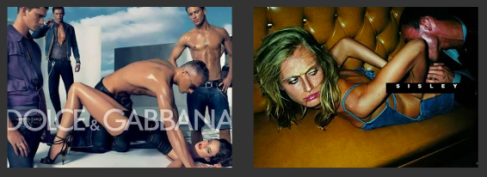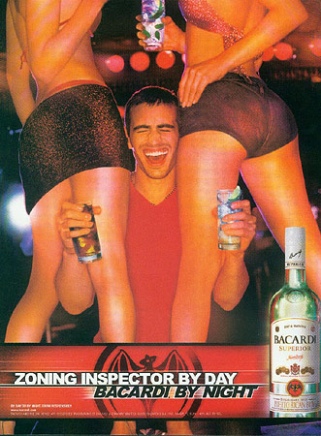Dear marketing executives, advertisers and video game creators,
As you probably know, on a typical day, the average American is consumed by media–spending 80 minutes texting and using social networking sites and email, 2.5 hours listening to music and 4 hours watching T.V. [1]. That is a significant amount of time, and I believe that because we consumers are so exposed to such vast amounts of media, we have become demanding and picky, choosing what we want to see and when we want to see it. And because we can now decide which shows we wish to watch, which magazines to subscribe to, and which commercials to fast-forward through, you media creators are forced to choose new tactics to differentiate yourselves from the others. Nowadays, instead of relying on traditional ideas to capture our attention, you are creating edgy, shocking images. From what I’ve observed, the most common (and probably most lucrative) approach you take is to utilize the well-known phenomenon, sex sells.
Your marketing knows exactly whom you are targeting and exactly how to get the message across. You know how to appeal to a women and how to appeal to a man. You prey on women’s insecurities and men’s desire for power. When the common individual views today’s advertisements, the message that you are sending to potential buyers is clear—you tell women how they should look, how they should act and what they should wear. Through marketing, advertising, movie and video game development you have created a world where the “ideal look” is comprised of flawless white women, with perfect faces and figures. We do not see women who are average looking, overweight, poor, disabled or struggling. When we see an advertisement, the gorgeous woman modeling appears to be saying, without words, “Hey! Look how pretty and happy I am! You could be like me too! Just buy this mascara!” We see beautiful people get a glimpse of their perfect lives, and instantly we envy them.
I believe this is exactly how all of you in the cosmetic industry wish us to react. You are profiting through the sale of the idea that it is possible to be as beautiful and successful and skinny as the girl in the ad, who is thinner than 98% of American women and photo-shopped to perfection [2]. This tactic is not only unfair and misleading, but also dangerous. There are more women than ever who do not think they are beautiful, who are getting cosmetic surgery, and who are suffering from eating disorders [3]. It is estimated that 80% of women and girls in America are not happy with their appearance, 48% have had or are considering plastic surgery, and 7 million suffer from eating disorders. They are all trying to become the women that they believe the world expects them to be [3].
Unfortunately, it is not just within ads for makeup where we see this miss-portrayed image of women, but also see in advertising directed at men. Men’s ads often show women being objectified, using their body parts as a way to tell men, “Here—if you buy this product, you will get lucky tonight!’ These ads, video games, movies, T.V. shows, etc., don’t focus on women as individuals, but turn them into body parts and sexual prizes. What I think you don’t realize is that by objectifying women, you encourage men to think of women only in terms of their sexuality. And when you objectify someone, you take away his or her humanity. Turning a human being into a thing is almost always the first step towards justifying violence against that person. In rhythm 0, 1974, which was an experiment done by artist Marina Abramović, the limits of the relationship between performer and audience were tested when she assigned a passive role to herself, and gave the audience control to do whatever they wished with her body. What she observed was that in the beginning, the audience was cautious, but over time, as she continued to remain an object in their eyes, the audience began to act more aggressively. “What I learned was that… if you leave it up to the audience, they can kill you.” … “I felt really violated: they cut up my clothes, stuck rose thorns in my stomach, one person aimed the gun at my head, and another took it away. It created an aggressive atmosphere. After exactly 6 hours, as planned, I stood up and started walking toward the audience. Everyone ran away, to escape an actual confrontation.” (Abramovic)[4]
As it has become more and more normal for women to be objectified in the media, you have continued to push the envelope. You have become numb to objectification, and have progressed onto more extreme advertising tactics. Now, It has become normal for your advertisements not only to objectify women, but also to display these women in harmful situations. “Say you have a commercial that shows aggression or actual violence towards a woman, all that is doing to your influential audience is creating in their minds that this is okay.” (Jeff Lindberg, Domestic Violence expert).
One of the largest problems with media, advertisements and video games directed at men and boys are the amounts of violence being shown against women. “The typical American child will view more than 200,000 acts of violence, including more than 16,000 murders before age 18. Television programs display 812 violent acts per hour; children’s programming, particularly cartoons, displays up to 20 violent acts hourly”[5]. Through exposure to so much violence at an early age, when their brains rapidly developing, children are becoming desensitized to the violence they are viewing in ads and T.V. shows, and to the violence they are committing in video games. Over time, and after routinely being exposed to violence, it is easy to lose the ability to empathize with victims of violent acts.
In 2010, a very controversial Japanese game called Rapelay was banned from the U.S. Rapelay is a molestation game that allows you to sexually assault and terrorize a woman and her daughters on a subway. Although banned in the U.S., the game remains available in Japan, a country that is also experiencing the rampant occurrence of rapes. Where do those rapes occur? Subways. Now, a new law has been implemented, which segregates women riders within separate train cars, and which Japan hopes will prevent women from being attacked on public transportation. [6] This is only one example of how treatment of women in forms of media can affect behaviors in everyday life. Each year there are over 200,000 victims of sexual assault. 22 million women have been raped in their lifetime, and one-fourth of all women have experienced domestic abuse. [7]
While it is clear that violence stems from many other factors such as family abuse, poverty, mental disorders, etc., research has shown that exposure to media violence plays a significant role in the rise of violent behavior. And, while not everyone who engages in violent and objectifying media will abuse and objectify women, every exposure to violence increases the chances that some day a person will behave more violently than they otherwise would.
Thus, I must ask you this question: When we live in a culture where women are starving themselves to be more beautiful, and violent acts remain prevalent, why not take every possible action towards preventing violence, beginning with the casual violence we see everyday in the media? How about representing women in beauty ads in a more realistic way? And would it kill you to make your products less sexist, less objectifying and less violent? –Because if not, your actions may kill someone else.
Would that be too much to ask?
Sincerely,
A Victim of the Media
Author’s purpose:
I decided to write this piece because as a young woman growing up in this culture, I have seen and felt the impacts of the messages, which the media is sending. I have friends with severe eating disorders, friends who have been sexually assaulted, and like most people, have seen and heard about horrible violent acts going on each and every day around us. We live in a world where terrible things continue to happen everyday and it is not until we bring awareness to this matter, will it stop. It is not my intent to blame or villanize the companies putting out these ads and sexist media, I just hope that this letter give them the opportunity to take a step back and reflect on their actions.
Bibliography
[1] “American Time Use Survey Summary.” U.S. Bureau of Labor Statistics. U.S. Bureau of Labor Statistics, 22 June 2012. Web. 21 Mar. 2013. <http://www.bls.gov/news.release/atus.nr0.htm>.
[2] Katz, Nikki. “Body Image Statistics.” – Women and Body Image. N.p., n.d. Web. 01 Mar. 2013<http://www.personal.psu.edu/cap5202/blogs/women_and_body_image/about/>
[3] Katz, Nikki. “Body Image Statistics.” – Women and Body Image. N.p., n.d. Web. 01 Mar. 2013<http://www.personal.psu.edu/cap5202/blogs/women_and_body_image/about/>
[4] Andrew Fishman’s Art.” Andrew Fishman’s Art. N.p., n.d. Web. 21 Mar. 2013. <http://andrewfishman.tumblr.com/post/37878716069/marina-abramovic-rhythm-0-1974-marina>.
[5] “The Impact of Media Violence on Children and Adolescents: Opportunities for Clinical Interventions | American Academy of Child & Adolescent Psychiatry.” The Impact of Media Violence on Children and Adolescents: Opportunities for Clinical Interventions | American Academy of Child & Adolescent Psychiatry. N.p., n.d. Web. 21 Mar. 2013. <http://www.aacap.org/cs/root/developmentor/the_impact_of_media_violence_on_children_and_adolescents_opportunities_for_clinical_interventions>.
[6] “Japan Tries Women-Only Train Cars to Stop Groping.” ABC News. ABC News Network, 10 June 2005. Web. 21 Mar. 2013. <http://abcnews.go.com/GMA/International/story?id=803965>.
[7] “Statistics | RAINN | Rape, Abuse and Incest National Network.” Statistics | RAINN | Rape, Abuse and Incest National Network. N.p., n.d. Web. 21 Mar. 2013. <http://www.rainn.org/statistics>.
Interview:
Lindberg, Jeff. San Francisco Police, recognized as a Subject Matter Expert in Domestic Violence by the California Department of Justice. Personal Interview.



